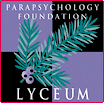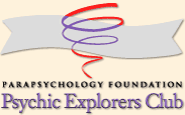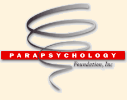 |
 |
| Dean Radin  For as long as I remember, I felt that there was far more to mind and life than what our ordinary senses implies. I was raised in an artistic, intellectual, agnostic family where education and creativity were strongly encouraged. I became interested in parapsychology as a teenager after I discovered that some of the mental “powers” I had read about from legendary yogic tales could be tested scientifically. In my teens I conducted experiments to explore these abilities, but I also had a strong practical streak so I didnít consider pursuing parapsychology as a career. For as long as I remember, I felt that there was far more to mind and life than what our ordinary senses implies. I was raised in an artistic, intellectual, agnostic family where education and creativity were strongly encouraged. I became interested in parapsychology as a teenager after I discovered that some of the mental “powers” I had read about from legendary yogic tales could be tested scientifically. In my teens I conducted experiments to explore these abilities, but I also had a strong practical streak so I didnít consider pursuing parapsychology as a career.
Besides reading books about psychic research, I read voraciously in mathematics, physics, science fiction, and mythology. The activity I spent most time on from age 5 to 25 was music; I was a violin prodigy and played professionally for about a decade. In college I initially assumed I would pursue a career as a concert violinist, but ultimately I leaned towards the more practical directions of engineering and physics. I eventually graduated with a masters degree in electrical engineering and a PhD in experimental psychology, both from the University of Illinois at Champaign-Urbana. For a decade after graduate school I worked at AT&T Bell Laboratories and later at GTE Laboratories on advanced telecommunications products, systems, and operations centers. Those years served as a good training ground to learn what is possible to accomplish when the engines of Big Science and technology are operating at full steam. I retained my interest in parapsychology while working in industry, and I managed eventually to gain research appointments to study psi phenomena full-time at Princeton University, University of Edinburgh, University of Nevada, SRI International and Interval Research Corporation. In 2000 I co-founded the Boundary Institute in Silicon Valley, and since 2001 I’ve been Senior Scientist at the Institute of Noetic Sciences. A few years ago I realized that I’ve spent the majority of my professional career in parapsychology. Support for my research has come from federal and state funds, private donors, and public foundations. Compared to the conventional academic and industrial research I’ve conducted, I’ve found parapsychology to be far more interesting and professionally challenging, but it’s also more frustrating because little is understood about psi, funding is unusually difficult to obtain, and progress is slow. When students ask me about pursuing a career in parapsychology, I first respond by saying that I’ve found nothing more exciting than working at the frontiers of science, but then I add that this type of research is definitely not for everyone. You have to be comfortable tolerating the ambiguity of not knowing the “right answer” most of the time. And you must be able to withstand severe criticism, even hostility, from people who don’t understand your interests. Regardless of your specialty within parapsychology, to fully appreciate the topic it helps to be familiar with the history, philosophy and sociology of science, with experimental methods, statistics, basic physics, biology, and psychology, and with the substantial literature of parapsychology. I’ve learned that only a small proportion of students, perhaps 10% of those who express an interest in parapsychology, have the combination of intellectual capacity, temperament, persistence, and skills to pursue this domain professionally. Most who think that they’re interested imagine that being a parapsychologist is something like being one of the ghostbusters from the movie of the same name, and they soon learn they aren’t really interested in science or serious scholarship. My main contributions to parapsychology so far have been the advancement of experimental and analytical methods for studying mind–matter interaction phenomena in individuals and groups, mind–body interactions at a distance, and precognition. I’ve also developed a variety of new analytical approaches, and have applied the techniques of meta-analysis to the mind–matter interaction literature. I’ve written two popular books on parapsychology, including The Conscious Universe (1997, HarperCollins) and Entangled Minds (2006, Simon & Schuster), and I’ve consulted on or written forwards and chapters for several other books. I am also one of the featured scientists in the popular independent movie, What the Bleep: Down the Rabbit Hole, and appeared in the special features documentary for the movie Suspect Zero. Radin, D. I. (2006). Entangled minds: Extrasensory experiences in a quantum reality. New York: Simon & Schuster. Radin, D. I. (2005). What’s ahead? In M. A. Thalbourne & L. Storm (Eds.) Parapsychology in the 21st Century: The Future of Psychical Research, Jefferson City, NC: McFarland. Radin, D. I. (2005). The sense of being stared at: A preliminary meta-analysis. Journal of Consciousness Studies, 12(6), 95–100. Radin, D. I. (2004). On the sense of being stared at: An analysis and pilot replication. Journal of the Society for Psychical Research, 68, 246–253. Radin, D. I. (2004). Electrodermal presentiments of future emotions. Journal of Scientific Exploration, 18, 253–274. Radin, D. I. (2004). Event related EEG correlations between isolated human subjects. Journal of Alternative and Complementary Medicine, 10, 315–324. Radin, D. I. (2003). Thinking about telepathy. Think (Journal of the Royal Institute of Philosophy, London, England) 3, 23–32. Radin, D. I. (2002). A dog that seems to know when his owner is coming home: Effects of geomagnetism. Journal of Scientific Exploration, 16(4), 579–592. Radin, D. I. (2002). Exploring relationships between random physical events and mass human attention: Asking for whom the bell tolls. Journal of Scientific Exploration, 16(4), 533𤰔. Radin, D. I. (2001). Seeking spirits in the laboratory. In J. Houran, & R. Lange, (Ed.), Hauntings and Poltergeists: Multidisciplinary Perspectives. Jefferson, NC: McFarland & Company. Radin, D. I. (1997). The conscious universe. New York: HarperEdge. Radin, D. I., Machado, F. R. & Zangari, W. (2000). Effects of distant healing intention through time and space: Two exploratory studies. Subtle Energies and Energy Medicine, 11(3) 207–240. Radin, D. I. & Nelson, R. D. (2003). Meta-analysis of mind–matter interaction experiments: 1959–2000. In W. Jonas, & C. Crawford (Eds.), Healing, Intention and Energy Medicine. London: Harcourt Health Sciences. Radin, D. I., & Rae, C. (2000, August). Is there a sixth sense? Psychology Today, 44–51. Radin, D. I. & Schlitz, M. J. (2005). Gut feelings, intuition, and emotions: An exploratory study. Journal of Alternative and Complementary Medicine, 11(4), 85&$150;91. Radin, D. I., Taft, R. & Yount, G, (2004). Possible effects of healing intention on cell cultures and truly random events. Journal of Alternative and Complementary Medicine, 10, 103–112. Schlitz, M. & Radin, D. I. (2003). Telepathy in the ganzfeld: State of the evidence. In W. Jonas, & C. Crawford (Eds.), Healing, Intention and Energy Medicine. London: Harcourt Health Sciences. |
 |

|
 www. parapsychology. org |
||